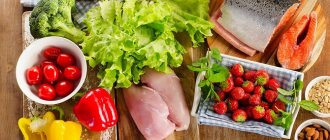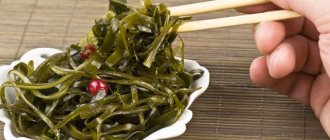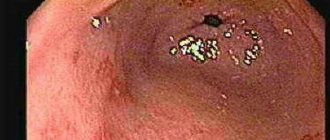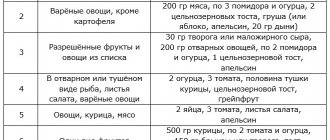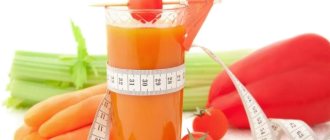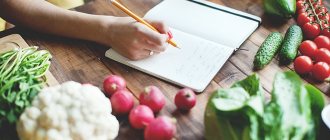Nutrition for gastritis: what can and cannot be eaten?
Gastritis is one of the most common diseases of our time. Frequent snacks and meals on the run, a wide variety of fast food, poisoning with low-quality food - all this can cause gastritis. This is probably why many people now suffer from stomach problems. But how to deal with them?
To do this, it is not at all necessary to constantly take medications; the main thing in treatment is a correct and well-chosen diet, which will not cause irritation of the mucous membranes and exacerbation of the disease, but at the same time saturate the body with all the necessary macronutrients and vitamins.
Basic Rules
The main goal of a diet for gastritis is to adhere to a diet that ensures normal digestion. The treatment table for gastritis (per day) should contain:
- 90-100 gr. protein (and 60% are animals),
- 50-80 gr. fat (75% animal)
- 300-320 gr. carbohydrates.
Nutrition rules for gastritis:
- Knowing the measure. With gastritis, the saying “after eating there should be a feeling of slight hunger” is more relevant than ever. Firstly, the feeling of fullness occurs only 10-15 minutes after eating, and, secondly, a full stomach does not cope well with its functions, especially with gastritis.
- Diet. Firstly, you should follow a meal schedule (at the same time). Secondly, with gastritis, meals should be fractional, 4-5 times a day, but at the same time it is necessary to avoid snacks (they provoke “excess” secretion of gastric juice and reduce its production during breakfast/lunch/dinner, which disrupts processes of processing and assimilation of food). Reading while eating, watching TV and “eating while running” should be strictly excluded.
- Rest after eating. After each meal, you need to rest for 15-20 minutes (not necessarily sleep). You can read a book or listen to music.
- Chewing food. Chewing food for a long time (at least 25-30 seconds for each piece) promotes more thorough mechanical processing of food, which makes it easier for a sore stomach. In addition, hunger in this case is satisfied faster (which prevents overeating). Refusal of complex dishes
The total energy value should be 2200-2800 kcal.
TUESDAY
Breakfast: oatmeal with milk with raisins and apples (exclude spices, raisins as tolerated)
Lunch: chicken noodle soup; baked apples with cottage cheese
Afternoon snack: fruit cocktail with kefir and cottage cheese (I recommend replacing canned apricots with fresh or peaches)
Dinner: fish balls like in kindergarten + mashed potatoes (excluding lemon juice)
Nutritionist's comment:Everyone knows that porridge is an ideal breakfast; it contains complex carbohydrates that keep you full for a long time, and pumpkin will enrich the dish with vitamin A. I recommend that people suffering from digestive system diseases regularly include soup in their diet. It is easily digestible, satiating and helps prepare the digestive system for the next meal. |
Nutrition for high acidity
For this form of gastritis, it is recommended to use a diet aimed at thermal and mechanical sparing of the stomach, as well as at reducing gastric secretion.
Authorized products:
- casseroles, cheesecakes, dumplings, oven-baked cheesecakes;
- milk, especially with tea, all types of fermented milk products, including yogurt and curdled milk, fresh pureed cottage cheese;
- fish, meat or chicken soups cooked with cereal broth;
- white dry crackers, vegetable and butter, milk soups with cereals or pasta;
- steamed omelettes, eggs in a bag, vegetable dishes in the form of purees, puddings, souffles, weak tea, sweet fruits and berries in jelly, creams and compotes;
- veal, lean beef, chicken in the form of meatballs, puddings, zraz, steam cutlets (it is allowed to eat lean boiled meat in pieces 1-2 times a week).
Prohibited products:
- fatty mushroom and meat broths;
- carbonated drinks;
- smoked meats with spices;
- raw vegetables, pickles, marinades, spicy vegetable snacks, lemon juice;
- black bread.
The purpose of the diet for exacerbation of gastritis with high acidity is to normalize the functioning of the intestines and stomach, limiting thermal, chemical and mechanical irritants.
Reviews and results
Most diseases of the digestive system have a chronic course, and exacerbation is most often associated with errors in nutrition. Chronic gastritis is no exception. Only following dietary recommendations can keep the disease in a state of stable remission. Many patients confirm this and consider the need for mechanical sparing and adherence to food intake to be important.
- “... I was often bothered by heartburn, but I didn’t attach any importance to it. I drank either soda or pharmaceutical drugs for heartburn. When stomach pain, heaviness and belching appeared, I decided to see a therapist. We discovered gastritis (good thing there is no ulcer or erosion) with high acidity. There was no need for hospitalization; treatment was carried out on an outpatient basis. The doctor warned about the need to follow a diet during the exacerbation period. I followed it for one month. Only for the first week I made my own pureed dishes, and then they were no longer pureed, but well-cooked and subdued. Most often I used minced meat. Of course, everything was boiled or baked in foil without a crust - consider it steamed. After such nutrition and treatment, I began to feel great, I didn’t even think that nutrition had such an effect. For a month there was never any discomfort or heartburn”;
- “... Gastritis has been around for many years and I notice that it worsens after stress and if I eat spicy and fried foods. In the fall, there are also often exacerbations. I immediately switch to dietary nutrition, add De-nol or Vikalin and Omeprazole. So far I have managed without a hospital. I normally maintain therapeutic nutrition for 3 weeks, and then expand it a little. I have forever excluded spicy, sour and smoked foods - this makes me feel worse and causes heartburn. Sometimes I can eat fried food, but not much. My wife makes me cutlets, adds a little boiled onion and dill to the minced meat and bakes them in the oven with sour cream. I eat soups more often and sometimes borscht”;
- “... If during an exacerbation you immediately switch to medical nutrition, drink a decoction of chamomile and calendula, Lansoprazole, then in 3 weeks you can restore your stomach. I’ve already learned the diet well, and in a steamer I can quickly make cutlets or boil fish with vegetables. I immediately puree the vegetables and add oil. I eat well mashed porridge and mashed potatoes. Of course, it’s not possible to cook for yourself every day, as recommended. I make soup and cutlets or meat casseroles for 2 days. The only difficulty I see is that I have to take dietary food with me to work and heat it up there.”
Nutrition for low acidity
The purpose of the diet for gastritis with low acidity is to stimulate (in moderation) the production of gastric juice, as well as to mechanically spare the stomach.
Prohibited foods for hypoacid gastritis:
- restriction of pearl barley, legumes, millet;
- fresh bread, rich pastries (“heavy” food for the stomach, makes chemical and mechanical processing difficult);
- fatty and salty fish;
- vegetables and fruits with coarse fiber (white cabbage, turnips, radishes, cucumbers, bell peppers), mushrooms;
- fatty meat, meat with fascia (films), canned food, smoked meats (inadequate mechanical processing of food, excess release of hydrochloric acid);
- sharp and salty cheeses, milk – neutralizes hydrochloric acid;
- berries with grains or thick skin (raspberries, strawberries, red currants, gooseberries, figs);
- spices and spices (irritate the gastric mucosa), as well as chocolate, grape juice, alcohol;
- lard and fat from pork, beef, lamb (not digestible due to low production of hydrochloric acid, difficult to digest foods).
Food should be taken after the secretion of hydrochloric acid begins, that is, in the first phase (advertising or programs about food, beautiful photographs of food, “delicious” conversations can provoke the release of gastric juice).
General information
Gastritis is an inflammatory disease of the gastric mucosa.
Over a long period of time, gastritis leads to disruption of various functions of the stomach, mainly by disrupting the production of hydrochloric acid and the associated digestion process. For a long time it was believed that the main cause of gastritis lies in a violation of the diet. However, today a number of authoritative studies have established that a violation of the diet is an insignificant factor in the development of gastritis. There are several real reasons for this pathology:
- The bacterium Helicobacter pylori. According to statistics, up to 90% of all gastritis have a bacterial etiology. In the aggressive environment of the stomach (where there is concentrated hydrochloric acid), the vast majority of bacteria die. However, Helicobacter pylori manages to survive and reproduce in such unfavorable circumstances. During their life, H. pylori bacteria release toxic substances that cause an inflammatory reaction and encourage the stomach lining to secrete more acid. Thus, the walls of the stomach become defenseless and ulcers can form on them.
- Alcohol abuse. Alcohol negatively affects the condition of the epithelial tissues lining the inner wall of all organs of the gastrointestinal tract. In addition to direct irritation, alcohol also increases the production of gastric juice, thereby increasing the likelihood of damage to the mucous membranes by hydrochloric acid.
- Reflux. A continuation of the stomach is the duodenum, into which the bile duct opens. If the functioning of the pylorus (the sphincter that separates the stomach from the duodenum) is impaired, reverse reflux of bile is possible. This process is called duodenogastric reflux. Bile and intestinal contents irritate the gastric mucosa, which leads to the development of inflammatory processes. It is noteworthy that attacks of duodenogastric reflux also occur in healthy people. Gastritis develops only after a number of such episodes. Often, the reflux of intestinal contents into the stomach causes chronic gastritis.
- Autoimmune processes. As you know, cells of the immune system fight foreign microorganisms that enter the body from the outside. However, with some disorders, the immune system begins to attack the body's own cells. The cells of the gastric mucosa are no exception, and their immunity can also be attacked. Autoimmune gastritis is a relatively rare phenomenon and accounts for only 5% of cases.
- Eating disorder. Some eating habits can cause inflammatory pathologies of the esophagus and stomach. For example, a passion for eating too rough food, which injures the mucous walls. It was previously believed that spicy foods and coffee contribute to the development of gastritis, but recent research does not confirm this. If a person does not have diseases of the gastrointestinal tract (GIT), then spicy food will not harm him. The national cuisines of many southern countries are replete with spicy dishes, but this does not in any way affect the incidence of gastritis and other gastrointestinal pathologies. The opinion regarding long breaks and fasting is also questionable. There is no convincing evidence that short-term fasting (up to 24 hours) contributes to the appearance of gastritis.
- Medications. Some drugs (particularly non-steroidal anti-inflammatory drugs) can cause gastritis. If you need to take these medications regularly, be sure to talk to your doctor about side effects.
- Other factors. Gastritis can also occur due to allergic reactions, parasites and radiation exposure.
The bacterium Helicobacter pylori.
Photo: k_e_n / freepik.com Gastritis goes through several stages in its development. Initially, when exposed to unfavorable factors, the gastric mucosa turns red and swells. As the disease becomes chronic, the stomach wall thickens. As the disease progresses, the affected areas of the gastric mucosa become thinner and atrophy. At this stage, the epithelial cells of the stomach are replaced by connective tissue cells (scars appear). At the last stage, erosions and ulcers appear.
Important! Since advanced stages of gastritis are fraught with the appearance of erosions and ulcers, it is important to begin treatment measures as early as possible. This will stop the pathological process and avoid complications.
Depending on the nature of the course and etiological factors, different types of gastritis are distinguished.
According to the nature of the flow:
- Acute - develops suddenly, for example, with an allergic reaction, alcohol abuse or poisoning. The acute form of the disease is characterized by severe pain, heartburn and nausea. A characteristic feature of acute gastritis is its transience. With proper treatment and timely elimination of the unfavorable factor (allergen, alcohol, toxins), the disease goes away within a few days.
- Chronic - develops slowly and has mild symptoms. A person may not be aware of chronic gastritis for years, which makes it more dangerous than acute gastritis.
Man with stomach pain.
Photo: drinkins / freepik.com According to the nature of inflammation:
- Erosive - characterized by the appearance of erosions on the gastric mucosa. This is one of the most common types of gastritis. As a rule, it develops in adults and very rarely in children.
- Atrophic is a type of chronic gastritis in which the secretory cells of the stomach atrophy. Thus, the production of gastric juice is reduced, which leads to a number of serious complications, including stomach cancer. Subatrophic gastritis is also distinguished, the clinical picture of which is similar to atrophic gastritis, but less pronounced.
- Catarrhal is an inflammation of the gastric mucosa caused by certain aggressive agents, such as infections, too hot or cold foods, toxins and other damaging factors. Catarrhal gastritis occurs in both acute and chronic forms. The development of a chronic form can be avoided if treatment is started on time.
- Superficial - represents the initial stage of inflammatory damage to the stomach. This is the most favorable stage of gastritis, which is easier to treat than others.
By localization:
- Antral - localized in the pyloric part of the stomach, where the hormone gastrin is secreted, which stimulates the production of gastric juice. With antral gastritis, gastrin synthesis increases, which leads to increased secretion of hydrochloric acid.
Diet for gastritis in the acute stage
The diet for gastritis in the acute stage deserves special attention. The requirements for products are the same as for all types of this pathology, but more stringent.
In acute forms of the disease, it is recommended:
- low-fat cottage cheese;
- yesterday's white bread and no pastries or baked goods;
- only lean meat, boiled and pureed or finely chopped;
- soups made exclusively with vegetable broths;
- non-acidic compotes and jelly;
- soft-boiled eggs or in the form of a steam omelet;
- vegetable purees from the baby food range; it’s also a good idea to borrow fish and meat purees from a jar from your kids;
- teas or infusions without sugar.
During the period of immediate exacerbation, the following are completely excluded from the menu:
- products with preservatives, flavor enhancers, artificial colors;
- raw vegetables and fruits;
- milk and any dairy dishes;
- all types of baked goods, except day-old bread;
- margarine, cooking oil and butter;
- pearl barley;
- all types of beans and beans.
All general restrictions on the products themselves and methods of their preparation also remain in force. Usually, the crisis passes in 3-4 days, then the diet becomes more varied, in accordance with the general recommendations for patients with gastritis.
Comments from nutritionists
During the period of exacerbation of the disease, it is important for patients to switch to a diet that excludes strong secretion stimulants and irritants. Therefore, it is important to know the following.
Mechanical irritation of the mucous membrane is caused by:
- large meals;
- a large amount of coarse fiber - they contain radishes, beans, turnips, radishes, bran bread, gooseberries, grapes, currants, dates, raisins;
- stringy meat, animal cartilage, poultry and fish skin.
Chemical irritation is caused by:
- sour foods (kefir, whey, yogurt), sour unripe fruits;
- broths, infusions of vegetables and mushrooms, spices, canned food, fried foods, smoked meat and fish products, pickled, salted and pickled vegetables, tomato sauce, stewed meat and fish, hard-boiled eggs, rye bread, butter dough, heat-treated edible fats ;
- strong tea, carbonated drinks, coffee, alcohol, raw vegetables (especially onions, garlic, radishes, radishes) and fruits.
Thermal effects are caused by very cold or hot food.
A gentle regimen, in addition to eliminating irritants, also provides for regular and small meals, which facilitates the digestion and absorption of food. Preference is given to foods that are quickly evacuated from the stomach - these are mushy and liquid dishes.
Taking into account all of the above, the patient’s diet during an exacerbation should include warm, non-rough, pureed dishes that have a weak juice effect. These are milk, eggs, milk porridge, boiled fish, minced meat, steamed.
Is it possible to fast with this disease? There is no clear answer. The positive effect of this treatment method is noted, but not always. Most foods significantly increase the secretion of hydrochloric acid; even just the entry of food into the oral cavity causes a reflex to release gastric juice. When fasting, these two factors influencing acidity are eliminated at once. Therefore, you can count on its reduction. The digestive system reduces the production of not only gastric juice, but also saliva, bile, and pancreatic enzymes. Peristaltic movements of the intestines are also reduced.
One of the signals about the need for food fasting is lack of appetite. The greatest effect of treatment is observed during the period of exacerbation, if fasting for 3-5 days is combined with the subsequent consumption of light foods. To achieve the effect, fasting is combined with water procedures and daily cleansing enemas. At the same time, decay products and toxins leave the body faster. On the other hand, therapeutic fasting reduces the body's vital resources. It should not be used for anorexia and severe weight loss, against the background of antibacterial, Helicobacter eradication and in pregnant women .
Hunger should not begin with a complete lack of food; first you need to switch to light foods, for example, kefir (during the day, in 5 meals, you can eat 900 ml of kefir, 200 g of cottage cheese, one apple). Such kefir fasting days are carried out for 2-3 days in a row, and then switch to fasting.
It can be performed in two versions - dry fasting (even drinking water is prohibited). The second option is to drink boiled or mineral degassed water. On the second day, you can drink weak tea. This goes on for 4-5 days. Resumption of nutrition begins with the consumption of rice water and crackers made from wheat flour. Then they switch to liquid, well-cooked oatmeal, rice and semolina porridge, which is boiled in water or with the addition of milk. You can consume cereal decoctions with soups and mucous soups throughout the day. It is prohibited to take fresh vegetables, fruits, and juices.
Today, among scientists there are those who are “for” and “against” separate nutrition for gastritis and other gastrointestinal diseases. The debate about its benefits and harms continues. The bottom line is that food is divided into three groups: proteins, fats and carbohydrates, which are consumed separately. The main prohibition is combining starches (cereals, pasta, legumes, starchy vegetables) and animal proteins in one meal. Meat can only be combined with non-starchy and green vegetables. Green vegetables, in turn, are combined with many foods: fats, cereals and proteins. Sugar and confectionery products should be consumed separately from all other foods, otherwise they cause fermentation, causing heartburn and belching . These are the basic principles of separate nutrition.
Proponents of this technique believe that the combined products are absorbed easily and quickly, do not cause rotting or fermentation, and toxic substances do not appear in the blood and intestines. At the same time, digestion and metabolic processes are normalized, overeating is eliminated and weight is normalized.
However, there are no scientifically proven facts about the benefits of this diet. Scientists still believe that mixed nutrition is more natural and beneficial for humans. The principles of separate nutrition contradict the habits and traditions of our national nutrition. Strict adherence to it in everyday life is difficult. In addition, organizing a new diet is accompanied by a feeling of hunger, and mental discomfort can result in uncontrolled gluttony. The choice is yours; if it is possible to organize it and as a result you get good health results, then it is quite possible to adhere to such a diet constantly.
Diet No. 1 can be used for weight loss. Of course, you cannot count on significant weight loss, but limiting fats, carbohydrates, baked goods, as well as steaming or boiling foods will affect your weight. Thus, this is a smart way to lose weight and not cause aggravation of gastritis.
Sample menu for the week
To get an impression of the diet, you can look at the approximate menu of the diet for gastritis of the stomach for a week with recipes. There is a clear fractional diet schedule: eating several times a day. This weekly meal plan is attractive and meets your energy needs thanks to its well-thought-out calorie content.
Day 1:
- Breakfast - buckwheat, milk soufflé, tea.
- Second breakfast - 1 glass of sweet oat broth.
- Lunch - slimy rice soup, spaghetti with beef zrazy, boiled carrots and peas, cocoa with milk.
- Afternoon snack - fermented milk cottage cheese.
- Dinner - vegetable casserole, steamed meatballs, light herbal decoction with honey.
- Before going to bed - 1 glass of fruit jelly.
Day 2:
- Breakfast - boiled egg, dried bread, boiled oatmeal, apple and rose hip decoction.
- Second breakfast - compote of boiled dried fruits (1 glass) and dry biscuit.
- Lunch - buckwheat soup, pumpkin puree, chicken zrazy, tea with milk (possibly adding sugar).
- Afternoon snack - 1 glass of milk, curdled milk, kefir and toast (fried bread is not allowed).
- Dinner - noodles with steamed beef patties, sour cream vegetable salad, cocoa. Before bed: 250 grams of low-fat fermented baked milk.
Day 3:
- Breakfast - oatmeal, boiled fish, tea with milk;
- Second breakfast - milk jelly.
- Lunch - vegetable soup with chicken, mashed potatoes and carrots, steam cutlet, cocoa with milk.
- Afternoon snack - fermented milk cottage cheese.
- Dinner - meatball with boiled peas, toast, dried fruit compote.
- Before bed - kefir or milk.
Day 4:
- Breakfast - fermented milk cottage cheese with honey, toast, dried fruit compote.
- Second breakfast - kefir or 1 glass of milk.
- Lunch - mashed potato soup, vegetable and rabbit casserole, dried fruit compote.
- Afternoon snack - milk mousse or soufflé with fresh fruit.
- Dinner - rice porridge with boiled rabbit, boiled carrots and peas, tea with milk.
- Before bed - cocoa with milk and 2 oatmeal cookies.
Day 5:
- Breakfast - boiled egg, dried bread, boiled oatmeal, cocoa with milk.
- Second breakfast - 1 glass of sweet oat broth.
- Lunch - pea soup, steamed fish, baked pumpkin.
- Afternoon snack - milk jelly.
- Dinner - vegetable casserole, steamed fish, rosehip broth.
- Before bed - 1 glass of kefir and oatmeal cookies.
Day 6:
- Breakfast - buckwheat milk groats, milk soufflé, tea.
- Second breakfast - baked fruit and a glass of milk.
- Lunch - pureed cauliflower soup, zrazy with rice, cocoa with milk.
- Afternoon snack - vegetable casserole and tea.
- Dinner - steamed fish with carrots and peas, salad with vegetables and sour cream, rosehip broth.
Day 7:
- Breakfast - baked apples with curd and raisin filling, toast, juice.
- Second breakfast - kefir or milk.
- Lunch - vegetable soup with chicken, mashed potatoes and carrots, steam cutlet, cocoa with milk.
- Afternoon snack - fermented milk cottage cheese with honey.
- Dinner - noodles with boiled chicken, baked pumpkin, cocoa with milk.
- Before bed - 1 glass of fruit jelly.
The acute stage of the disease with such nutrition will quickly go into the stage of remission of gastritis.
Menu for the week, option No. 2
People who follow a diet for gastritis are advised to plan their menu for the week in advance with recipes. A clear action plan will help you avoid unhealthy snacks. It is much easier when the patient’s refrigerator is stocked with the necessary products. And the person knows how and what can be quickly prepared from them.
Monday:
- Morning - 7:00. Steamed fish cutlet. Boiled potatoes. Tea.
- Reinforcement - 10:00. Low-fat cottage cheese.
- Lunch - 13:00. Barley soup with vegetables. Buckwheat porridge with boiled meat. Compote.
- Reinforcement - 16:00. Sweet crackers. Carrot juice.
- Dinner - 18:30-19:00. Chicken meatballs baked in the oven. Mashed potatoes with water. Charlotte. Tea.
- At night - 21:00. A glass of low-fat kefir.
Tuesday:
- Morning - 7:00. Oatmeal with egg white omelette. Tea.
- Reinforcement - 10:00. Baked apples.
- Lunch - 13:00. Vegetable low-fat soup. Rice porridge with boiled chicken. Compote.
- Reinforcement - 16:00. Sweet crackers. Rosehip drink.
- Dinner - 18:30-19:00. Mashed potatoes with a piece of lean fish. Semolina pudding. Kissel.
- For the night. A glass of low-fat kefir.
Wednesday:
- Morning - 7:00. Rice porridge with turkey meatballs. Tea with milk.
- Reinforcement - 10:00. Cottage cheese casserole with low-fat sour cream.
- Lunch - 13:00. Vegetable soup. Rabbit meat cutlets steamed with vegetable stew. Compote.
- Reinforcement - 16:00. Sweet crackers. Rosehip drink.
- Dinner - 18:30-19:00. Oatmeal with half and half milk and chicken meatballs. Juice from fresh berries.
- At night - 21:00. A glass of low-fat kefir.
Thursday:
- Morning—7:00. Boiled tongue. Semolina porridge with half and half milk. Tea.
- Reinforcement - 10:00. Baked apple.
- Lunch - 13:00. Vegetable soup with small vermicelli. Mashed potatoes in water with boiled turkey meat. Compote.
- Reinforcement - 16:00. Galette cookies. Rosehip drink.
- Dinner - 18:30-19:00. Potato casserole with minced meat. Tea.
- At night - 21:00. A glass of low-fat kefir.
Friday:
- Morning - 7:00. Buckwheat porridge with protein omelette. Tea with milk.
- Reinforcement - 10:00. Kissel.
- Lunch - 13:00. Vegetable soup. Chicken meatballs with boiled vegetable puree. Compote.
- Reinforcement - 16:00. Sweet crackers. Dried fruits compote.
- Dinner - 18:30-19:00. Mashed potatoes in water with boiled fish. Tea.
- At night - 21:00. A glass of low-fat kefir.
Saturday:
- Morning - 7:00. Oatmeal with half and half milk. Steamed fish cutlets made from lean fish. Tea.
- Reinforcement - 10:00. Low-fat fresh cottage cheese. Baked apple.
- Lunch - 13:00. Vegetable soup. Boiled potatoes. Beef stroganoff. Compote.
- Reinforcement - 16:00. Sweet crackers. Tea.
- Dinner - 18:30-19:00. Fish baked in the oven. Boiled carrot puree. Tea.
- At night - 21:00. A glass of low-fat kefir.
Sunday:
- Morning - 7:00. Meat soufflé baked in the oven. Oatmeal with half and half milk. Tea.
- Reinforcement - 10:00. Carrot-apple soufflé.
- Lunch - 13:00. Vegetable rice soup. Buckwheat porridge with steamed rabbit meat cutlets. Carrot-banana juice.
- Reinforcement - 16:00. Sweet crackers. Tea.
- Dinner - 18:30-19:00. Mashed potatoes with water. Boiled fish. Rosehip drink.
- At night - 21:00. A glass of low-fat kefir.
How long should a diet be followed for gastritis? Strict control is necessary during exacerbation and in the first months after. But ideally, a patient diagnosed with gastritis should adhere to the recommended table during remission. Although, menu expansion and holiday exceptions are possible. If only within reasonable limits, and if we are not talking about coffee, cigarettes, alcohol and fatty foods.
Can I...?
What is possible and what is not? List of basic foods and drinks.
- Fish - only low-fat types of sea fish, such as pollock, cod, hake. Among river fish, pike perch and pike are the best. It is better to avoid canned fish and fried fish altogether; during their production, all the beneficial properties of any fish are lost, and you can more than get a lot of spices, preservatives, and carcinogens. Like meat, it is better to steam fish, limiting the spices.
- Coffee - you should absolutely not drink black coffee if you have gastritis on an empty stomach, even in large quantities, especially with increased stomach acidity. With low acidity, coffee or cocoa with milk is allowed, but only in limited quantities.
- Meat - you can eat with gastritis, but only low-fat varieties - beef, veal, chicken, rabbit. Steamed cutlets are especially useful for gastritis, since the meat is finely chopped and steamed. If it’s just steamed meat, then you should chew it very carefully and not overuse the quantity, since any meat product is a burden on the stomach. Naturally, neither smoked nor raw smoked sausages and sausages should be consumed if you have gastritis.
- Cheese - sharp or too salty cheeses are not allowed for any gastritis; even ordinary hard cheese should be consumed in limited quantities in small slices.
- Bananas – Can you eat bananas if you have gastritis? This is a healthy fruit that contains a little fiber, it is soft, easily digestible and contains a lot of useful substances that the body needs. And although diet No. 5 prohibits fruits such as dates and bananas, many gastroenterologists believe that their moderate consumption cannot harm and bananas should and can be eaten for gastritis.
- Watermelon is something you can eat if you have gastritis, but only a little bit. Regardless of acidity, you can eat only 1-2 slices.
- Melon is almost the hardest plant product not only for the stomach, but also for the pancreas and gall bladder. The gastrointestinal tract of even an absolutely healthy person has a hard time dealing with melon, so anyone who suffers from gastritis should avoid such a dubious product.
- Chocolate - it is better to avoid this product completely.
- Nuts, seeds, legumes - no types of nuts should be consumed if you have gastritis, the same goes for seeds and legumes.
- Honey can be consumed because it has wound-healing properties and is considered a fortified and healthy product. However, everything is good in moderation, especially since many people may be allergic to bee products.
Is it possible to completely get rid of gastritis?
In mild cases, with superficial gastritis, it is possible to cure it completely if you lead a healthy lifestyle and follow the following strict rules, which in practice turns out to be quite a difficult task:
- Meals should be 5-6 times a day, at certain hours, the last meal should be at least 2 hours before bedtime.
- Constant adherence to a diet, no dry food, no fast food.
- Avoid smoking and drinking alcohol.
- Avoid any overeating and long breaks in meals.
- No physical overexertion, constantly monitor the condition of the body, do not overwork, do not overstrain, sleep at least 8 hours a day at night and preferably 1 hour during the day.
It is also worth working on yourself to develop resistance to stress (stress tolerance), or to eliminate psycho-emotional overload.
Diso Nutrimoon
Protein for treatment and rehabilitation
An easily digestible, tasteless protein mixture, a source of proteins and amino acids necessary for the body to fight illness, recover from injuries, illnesses and operations.
More details
Enriching the diet with protein of high biological value "DISO®" "Nutrimun" will provide a person suffering from gastritis with adequate nutrition and at the same time sparing the digestive organs.
Follow your doctor's recommendations, and recovery will not take long. By maintaining healthy eating habits throughout your life, you will reduce the risk of relapse to a minimum.
